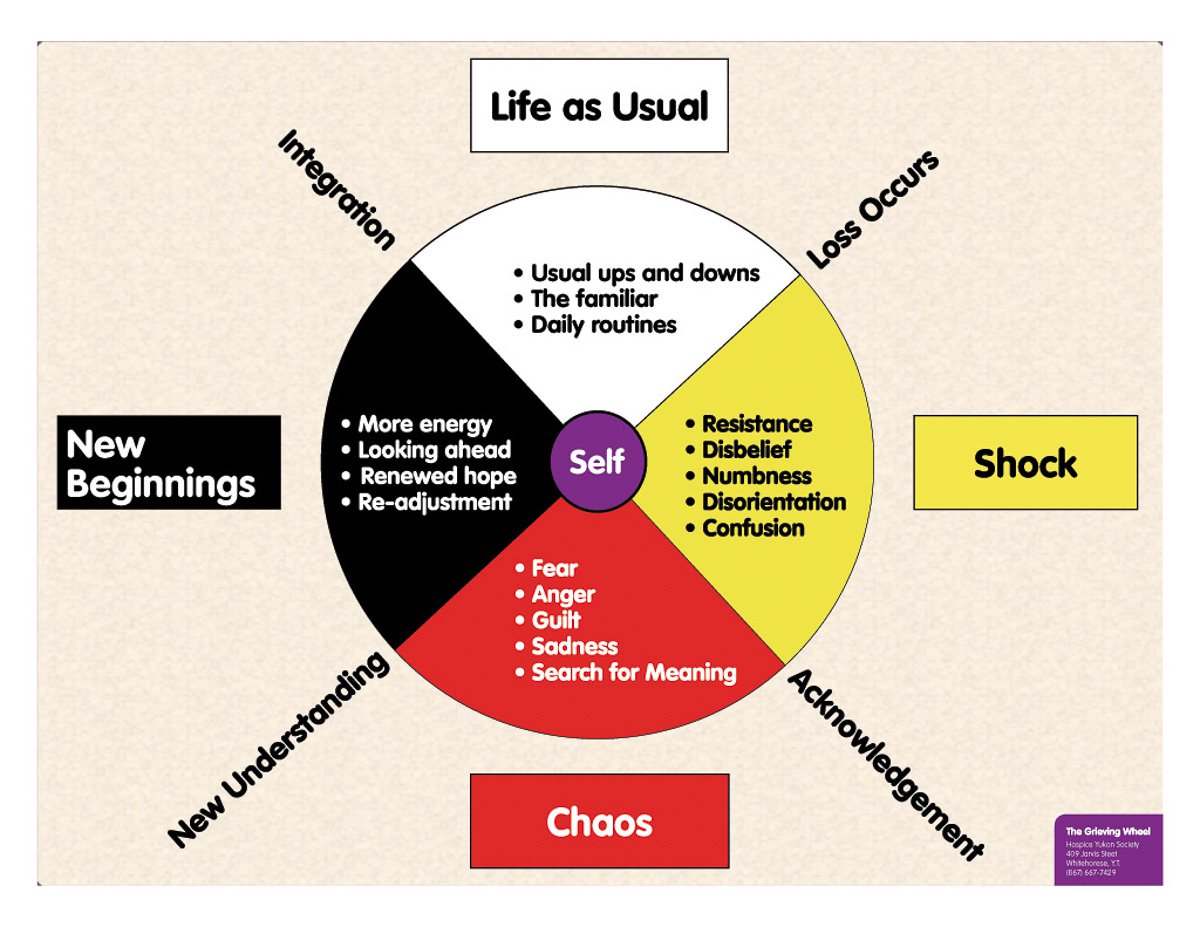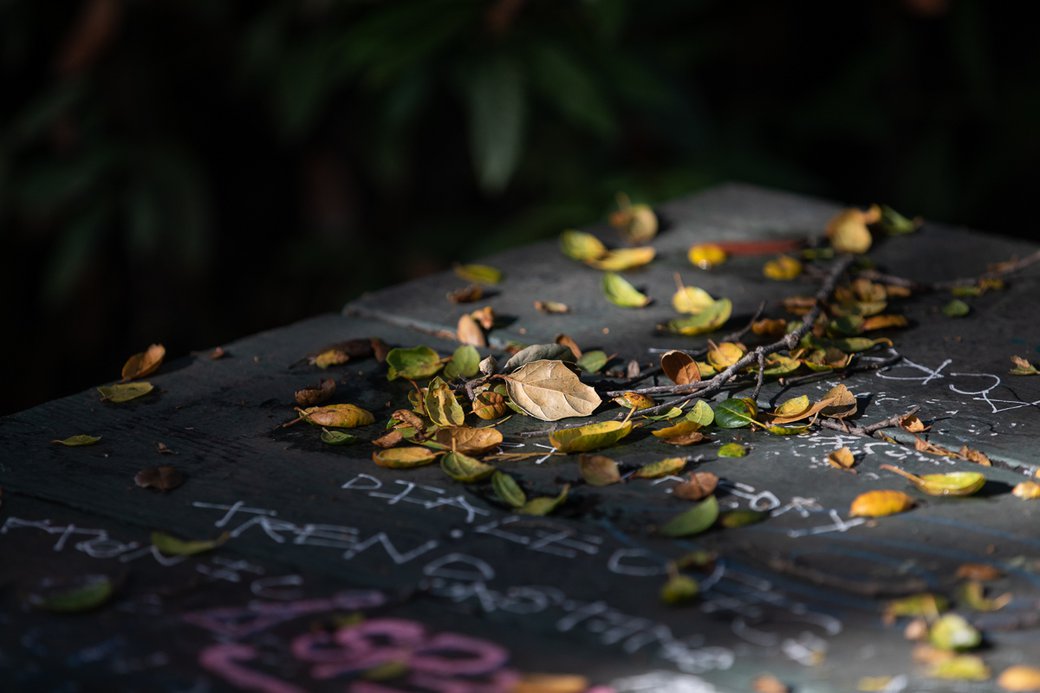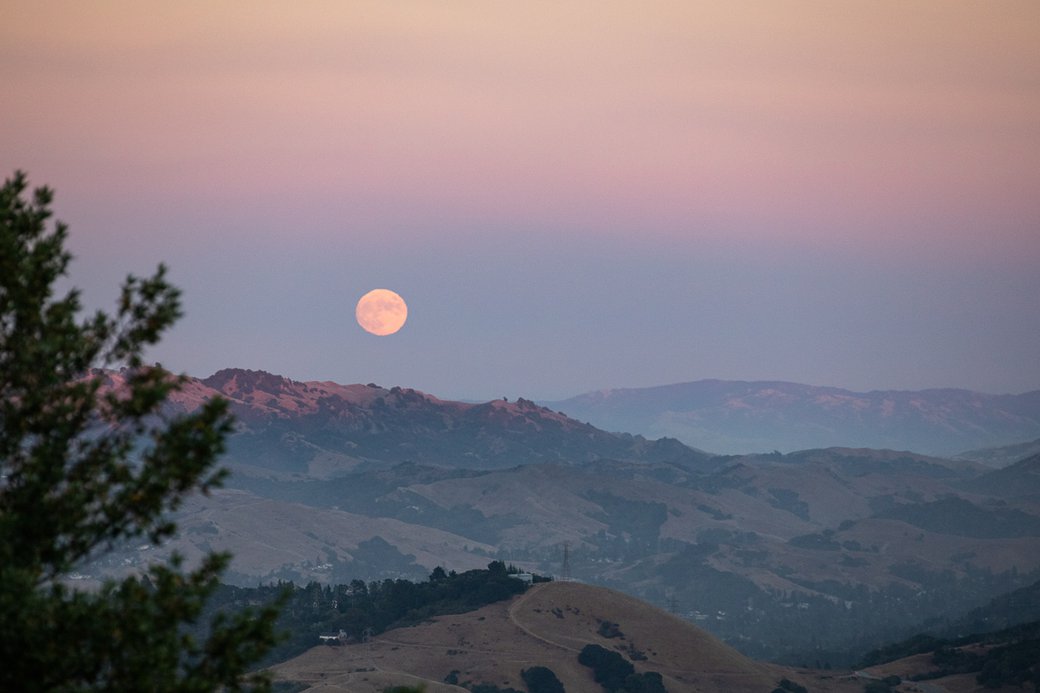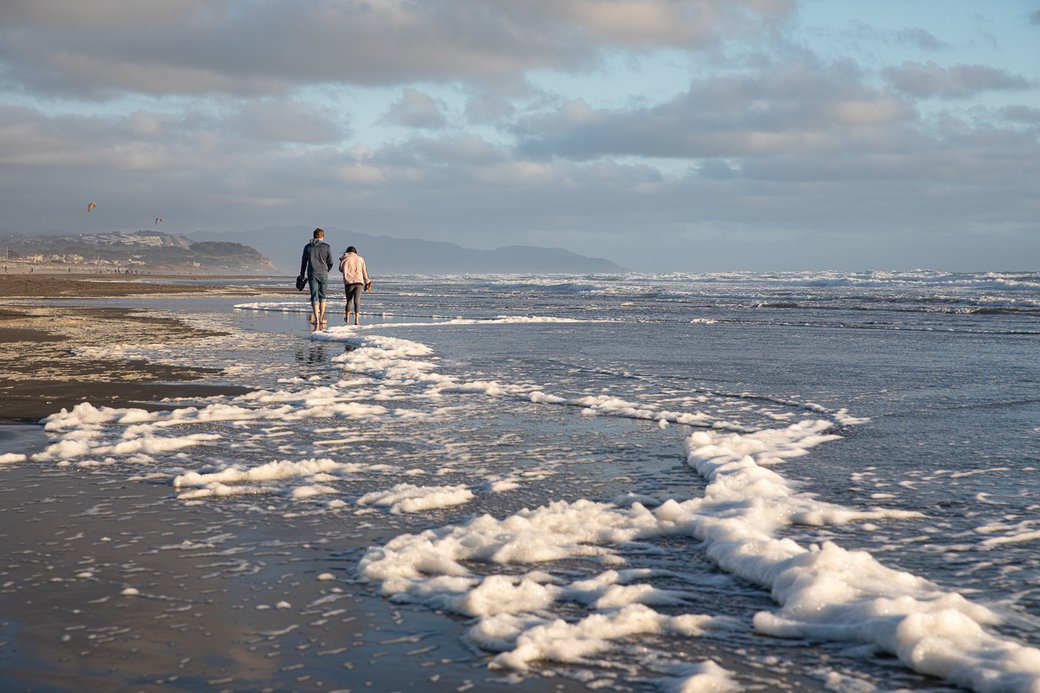A new vision for creating and learning online
CCA staff psychologists share tips for managing anxiety, developing a sense of community, and finding hope during the pandemic.
When COVID-19 led to shelter-in-place orders last spring, many of us found ourselves in a state of shock and disbelief. As campus closed down and in-person events were canceled, confusion, disappointment, and anger over what happened and what we lost set in. Summer brought more uncertainty as the pandemic surged, protests against racial injustice took place around the world, and wildfires burned across the West Coast. The Grieving Wheel below offers a visual representation of this cycle, showing how many of us coped as our former, familiar world seemed to collapse.

The Grieving Wheel: A Model of the Grieving Process by Hospice Yukon.
As our collective journey continues, how might we find ways to move beyond shock and chaos and turn toward new beginnings? What does it mean to be an artist during this time and how can we stay connected? We asked CCA Staff Psychologists Dr. Leah Oliver and Dr. Brigette Stump-Vernon to discuss their experiences and advice to help students find their path during this uncertain time.
This interview was conducted via email in September 2020 and has been edited for length and clarity.

Q. How can students manage their fears about uncertainty of the future?
Dr. Oliver: People are experiencing so much ambiguity about what is happening in the world today. Students who are embarking on a journey to identify themselves in their making practices and future careers undoubtedly will be faced with the task of working to build goals for their future in the midst of such uncertain situations taking place both personally and globally.
I remember a conversation I had with a professor when I was in my junior year of college. I was terribly anxious about how I was going to apply my degree in a way that would allow me to be and feel successful, and she encouraged me to reflect on why I had even chosen to get the degree in the first place. Her nudging felt frustrating at the time because I just wanted her to give me an answer, but I took her up on the prompt and it pushed me to remind myself of both my ambition and dedication to my vision and goals. I had lost access to them from time to time and it was helpful to know that my dream was still alive in me. I needed to go retrieve it, and I needed help to do so.
Students can find tools for managing fear and uncertainty in conversations with trusted people in their lives or self-care practices like meditation, healthiful eating, exercise, art making, and getting enough sleep. Support services such as counseling or support groups are also a really helpful way of navigating worries and fears. [Scroll down for some resources available to CCA students.] It’s important to keep in mind that uncertainty and fears about the future are normal and can be potential avenues for deeper self-discovery.
It’s important to keep in mind that uncertainty and fears about the future are normal and can be potential avenues for deeper self-discovery.”
Dr. Stump-Vernon: Anxiety, uncertainty, and fear are all valid feelings during this time and part of both our personal and global processes as we work to build a new future out of what can feel like fire and ashes right now. For some of us on the West Coast this is both figurative and literal. Fear and anxiety—and the biochemical, neurological responses they are related to—exist at a very basic level to keep us safe and alive. They exist to protect us. We are designed to react immediately to a threat to our lives; however, our current operating systems (i.e., how fear and anxiety are processed by our bodies and brains) struggle to discern what is an immediate threat to our lives and safety and what feels like an immediate threat. There is a difference between failing a class and an actual threat to our existence, but the failed class can feel like an existential threat because of how we perceive its impact on our future.
We need fear to keep us safe but we don’t need to let it hog the microphone or to tell us stories of futures that don’t exist or haven’t come to pass. Again the invitation here is to acknowledge the fear, because it’s trying to keep us safe, but to bring other parts of ourselves to the conversation, parts that remind of us of our resilience and help us to stay grounded and compassionate with ourselves and others and also remind us not to write the end or even the middle of a story that we haven’t lived yet.

Oakland at sunset.
Q. If a student is struggling to find inspiration, what would you suggest they do to find hope and motivation?
Dr. Oliver: I encourage them not to feel like they have to find it in one place or in one moment. There can be an ebb and flow. It’s growth, and growth is certainly not always a linear process! Students can give themselves permission for what I like to call “the void” to happen. It is in these unknown and often scary spaces that we get to change and transform into ways of being and thinking that we didn't know could be possible or best for us before they happen. It is in getting through them that can be the painful part.
Students who choose to embark on an art degree are creative people. Part of the creative process involves giving life to something that was once unknown—to ourselves and/or others. If students can maintain a curiosity about themselves and the world around them, they will inevitably be led to hope and inspiration.
How can students maintain or find curiosity? It can start with noticing where your focus goes on its own. Notice where you feel pulled to think or feel about something and then, over time, that seed can be nurtured and bloom. Inspiration can be a flash moment, but it can also be cultivated with practice.
Dr. Stump-Vernon: I find myself returning to surrender, or acceptance, with this question. We are managing a lot of little “deaths” right now, and we are in mourning for what we thought this year, time, space in our lives would look like. The more we fight to shoehorn ourselves into a narrative that is not possible right now, the more painful the contrast is between what we thought right now would be and what it actually is. It’s okay to acknowledge the loss, or “the void,” as Leah called it.
I keep thinking about fallow ground and how plants need to die to regerminate the soil to make space for new growth. This may be a fallow time for some folks right now, but that doesn’t mean creation isn’t happening, underground, outside of your immediate awareness. It may be a time where the best you can do is survive and get through, but this in itself is a process of resilience, of germinating your own internal soil so there can be possibility for growth and regrowth. It’s okay to let yourself “do enough” and “be enough” and, if possible, create, inspire, and hope from that place, to surrender to “enough” while you build resilience and recoup your resources.
It’s okay to let yourself ‘do enough’ and ‘be enough’ and, if possible, create, inspire, and hope from that place, to surrender to ‘enough’ while you build resilience and recoup your resources.”
Q. What can students do to stay connected in a remote, virtual environment? What steps can they take to build a sense of community?
Dr. Oliver: I think this is something that I am working to figure out for myself as well! This is new for all of us and we are all working to seek community that feels fulfilling in ways that have been that to us in the past. Students are connecting online through classes and other virtual platforms, but there is a sense of loss of what we have known in being able to engage with others because we are all so isolated from each other.
I encourage students to create their own kinds of online support groups that they can turn to. Students could choose themes or topics that they would like to have a conversation on and support around and then send out invitations through social media, listservs, and newsletters on campus. These groups could be held weekly, monthly, etc. Counseling is here to support students in being able to think about themes or topics that would feel helpful for them, and other Student Affairs staff can also support students in thinking creatively about how to build peer-led support systems.
Reaching out for support and help right now, whether through CCA leadership, faculty, or their peers, may be a crucial part of how students manage this difficult time.
Dr. Stump-Vernon: I second what Leah has said! Community is so integral to my own sense of well-being, and I continue to think with my own community about how to stay connected or what connection even looks like during a time of physical distance. I know that many folks, myself included, go through cycles of feeling that loss of physical closeness and then also appreciating that this is happening in a time where connection can still happen without physically being together. I also acknowledge that connecting online is work in a way that physical proximity isn’t—you have to agree upon where and how you will meet online versus the day to day of being in class together in a shared space, as well as the physical responses to a lot of time spent on a screen versus being physically near someone.
I echo a lot of what Leah has said in terms of students building online communities for various topics or themes they are interested in. Another thing that often connects folks is laughter, so having a group movie night where you watch something funny together is one way to connect. Music and dancing are also great connectors, so making time for an online dance party with people you care about can be a good time as well! I also feel like so many of our students are far more online and technology savvy than I am. So, students, feel free to share with your peers and with the CCA community: What are you doing to stay connected?
Mental health support for students
Q. What are some things students can do during the pandemic to help them find their place in the world and at CCA and in the world?
Dr. Oliver: Students can find their place at CCA in the communities that surround them, even though they may be virtual right now. There are multiple communities in which students have opportunities to build relationships with their peers, faculty, and staff. Investing in these relationships will also have an impact on creating a more in-depth understanding of their creative practice and intention in their artmaking. Over time, students will hone their self-perspective and making practice that will help them to understand themselves as CCA community members and artists. Perhaps now more than ever, with all that is happening in the world, finding meaningful community and connections with others is especially important.
Finding one’s place in the world can be thought about as a lifelong, dynamic practice. There are so many experiences and teachings that inform how we grow—our experiences as children, friendships that are meaningful to us, mentors who inform our personal ideologies, environments that we feel drawn to be in, how we choose to express creativity, our financial circumstances, goals for our future, etc. I could keep going!
Maybe what is helpful to consider is that we are constantly changing depending on the contexts we are in. We adapt and grow based on the situations we are in and that’s okay! Finding one’s place in the world is a process of growth and lifelong learning. As we age, it may become less ambiguous where we feel we belong as we’ve had more time on this planet to get to know ourselves, but I see it as an existential question for any age group. Students can ask themselves why they find themselves in the places they decide to be in, and this can inform their understanding of where they want to find themselves in the world moving forward.

Dr. Stump-Vernon: I also want to acknowledge that, right now, part of what is so difficult is that our places in the world and the identities we hold in relationship to those places, while often growing and changing over time, may feel more chaotic or precarious than they did in our past or before the pandemic began. What we felt we knew or understood about ourselves and the roles we play for ourselves and for others is shifting in the face of great uncertainty. This is both a challenge and an opportunity. The challenge is that we feel ungrounded and unsure about where we fit or what is a stable or grounded identity or identities that we can stand in or occupy, leaving many of us feeling very out of control.
The opportunity or invitation is that this space of transition is also alive with possibility and creativity. We are invited to ask ourselves, outside the norms of certainty and control, “Who do I want to be? What parts of myself do I want to nurture? What piece(s) of myself was I missing or unable to see when I was certain? Where can I surrender control, or perceived control, and make space for something else to flourish?”
One of my favorite quotes from Elizabeth Gilbert is: “You are afraid to surrender because you don’t want to lose control. But you never had control; all you had was anxiety.” Artists know this more so than a lot of folks, I think. There’s a surrender to the creative process, to the flow of making, that is essential to “getting out of one’s own way.” So the opportunity here is to try and apply this to our whole selves and our identities: How can we surrender to the ongoing flow of creation of who we are while staying grounded in our undeniable humanness and the pieces of our identities that we do feel grounded in? As Leah noted, this is a lifelong process, and very much dynamic within ourselves, as we work to figure out where to ground and where to expand. We’re all working on this, and counseling is a place where you can explore this further.
CCA Counseling & Psychological Services available for students
We’re dedicated to supporting CCA students as they find their way during this time of great uncertainty. Students who are currently enrolled and residing in California can set up weekly counseling appointments. Students who are currently enrolled and not residing in California can access CCA's Counseling & Psychological Services to learn more about what counseling support is available to them.


—Brooke Vlasich
October 22, 2020

